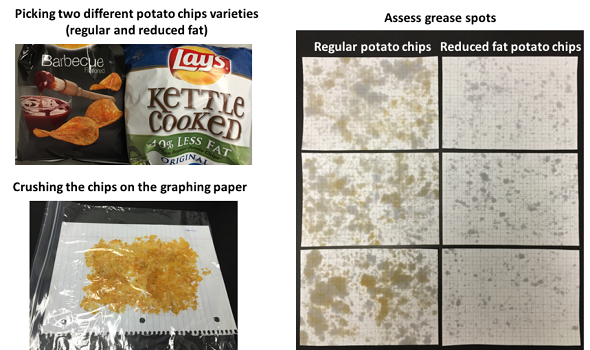Spot the Fat in Your Snack
Summary

Introduction
Do you love potato chips? If you do, you are not alone. Potato chips are a very popular snack food. In fact, many people eat more than one bag of chips per month. When eating potato chips, have you ever noticed that your hands get really greasy? Maybe you have heard people telling you not to eat potato chips because they are bad for you and contain too much fat. But is this really true? Do this activity and find out by making the fats in potato chips visible.
Background
Fats are a main component of our diet and are essential for our bodies to work. A healthy diet consists of about 20 percent fat. But why is fat useful to us? Well, body fat functions as an insulation layer to maintain our body temperature; it also protects our organs. Our body also uses fat for storing energy or for digesting essential fat-soluble vitamins. So why do we hear all these stories about bad fats that are unhealthy? The reason is that there are different types of fats in foods and not all of them are healthy.
If you have ever looked at nutrition labels of foods, you might have noticed that the fat category is subdivided into “saturated,” “unsaturated” and “trans” fats. The different names represent the different types of fats that result from different chemical structures of the fat molecules. But which of these are the “bad” and which are the “good” fats? Unsaturated fats—mostly found in plant-based foods and oils—have been shown to be beneficial to your health. Saturated fats—which mainly come from animal sources—have been associated with an increased risk of cardiovascular diseases. “Trans fats,” in particular, which come from food processing and do not occur in nature, should be avoided in a healthy diet.
Almost every food we eat has some amount of fat in it, often in an invisible form so we do not even notice it. Did you know that potato chips contain up to 35 percent fat? An easy way to make these fats visible is the so-called grease spot test. Grab some chips and see for yourself in this activity.
Materials
- Clean working area that can get greasy
- Graph paper
- Wax paper
- Two sheets of regular paper
- Rolling pin
- Scissors
- Timer
- Digital kitchen scale
- Two varieties of potato chips (use regular baked chips and reduced fat chips)
Preparation
- Find a clean working area that can get dirty and greasy.
- With your scissors, cut two pieces of graphing paper, approximately 18 x 12 cm (7 x 5 inches).
- Cut two slightly larger sized pieces of the wax paper.
- Take one sheet of the regular paper, the cut graph paper and the wax paper and label each one “Regular Chips.” Label the other set of papers with “Reduced Fat Chips.”
- On your kitchen scale, weigh about 28 grams (or 1 ounce) of each kind of potato chip, the regular and reduced fat variety. Set each pile aside on your table for now.
Instructions
- With your hands, take a couple of regular potato chips out of the bag. Look at them closely. Do they look very greasy?
- Crumble the potato chips with your fingers. How do your fingers look? Can you see some shiny grease on them? How do your fingers feel when you rub them against each other?
- Repeat steps 1 and 2 with the reduced fat potato chips. Do the chips look very different? Are your hands less greasy after you crumble them with your fingers?
- Clean your hands and put the sheet of paper labeled “Regular Chips” down on the table. Take the piece of graph paper labeled “Regular Chips” and place it on top of the regular piece of paper.
- Now, take the pile of regular chips that you prepared and spread them evenly on the graph paper so the whole area is covered with chips.
- Place the wax paper labeled “Regular Chips” on top of the chips.
- Carefully press down on the wax paper and crush the potato chips. Try to keep all the potato chips and pieces evenly spread out on the graph paper. Use the rolling pin to crush the chips into small pieces.
- Set your timer for 1 minute and let the crushed chips sit on the graph paper for 1 minute. After the 1 minute has passed, put the wax paper and the potato chips into the trash. Try to remove all of the extra chip bits from the graph paper, too. Do you notice a grease stain on the graph paper? How large is the grease stain?
- Tape the graph paper to a well-lit window so you can see the stain clearly and let it hang on the window for about 10 minutes. How much of the graph paper is covered in grease? Are there any areas that are not translucent? What are the sizes of the individual grease stains on the graph paper?
- Also look at the regular sheet of paper that was underneath the graph paper. Did any of the grease spots leak through the graph paper? How many grease spots do you see on this sheet of paper?
- Repeat steps 4-10 with the reduced fat chips. How does the grease spot on the graph paper look this time? Is more or less area of the graph paper covered with grease? What do you notice when you compare the sizes of the individual grease spots to the grease spots from the regular chips? On the underlying sheet, do you count more or fewer grease spots?
- Finally, look at the nutrition labels on both bags of potato chips. How much fat is in each of them? Do these numbers agree with your grease spot results?
Extra: As you look at the grease spots on the graph paper, try to count all the squares that are covered in grease; this way you also have a quantitative measurement of the fat content in the two different potato chips varieties. Compare the results for both of the chip varieties. Did you expect these results? How much more squares were covered in grease using the regular chips compared to the reduced fat chips?
Extra: What other foods do you think contain a lot of invisible fats? Try to produce grease spots with other foods that you find in your kitchen. Some examples of foods to try are nuts, chocolate, cheese or cereals. Were you surprised about any of your results?
Observations and Results
Did you see some really big grease spots on the graph paper after crushing the chips? This is no surprise, as fat is a major ingredient in chips, as you probably noticed when you looked at their nutrition labels. When you just look at the chips, however, you do not necessarily see all the fat they contain. Only when you crumble the chips with your hands do you start to detect these invisible fats as your fingers become very shiny and slippery from all the grease.
When crushing the chips on the graph paper, a big grease spot should have appeared. If you held the paper against a light source, you saw that all the areas covered with grease became translucent. Why is that the case? The reason why fats produce grease spots is that they are non-volatile, meaning they have a very high boiling point and do not evaporate easily. In contrast to water, fats that get absorbed by paper cannot get enough heat to evaporate at room temperature. An easy way to test this is to take a sheet of paper and put one drop of oil next to a drop of water. First, both areas look wet and translucent, but after a while, the water will evaporate and the spot will dry, whereas the fat spot will remain visible. This is because when fat is absorbed into the paper’s pores, the paper—which is normally white due to scattering light that shines through—becomes less scattered, and therefore becomes darker in color and translucent.
When you compared the two different potato chip varieties, you probably observed that most of the squares were covered with fat for the regular chips and the underlying sheet of paper might even have had significant grease stains as well. Using the reduced fat chips, however, should have resulted in a much lower area covered with grease, both on the graph paper as well as on the sheet of paper underneath. This makes sense as these kind of chips contain less fat that can be absorbed by the paper. So next time you get a potato chip craving, remember the grease spots on the paper and maybe you will change your mind and reach for a less fatty snack instead…
Ask an Expert
Cleanup
- Put all the paper in the recycle bin and discard the wax paper. Throw the crushed chips into the trash; you can still eat the remaining chips in the bag.
Additional Resources
- What is fat?, from TED-Ed
- Learning about fats, from KidsHealth
- How grease are your potato chips, from Science Buddies
- Science Activity for All Ages!, from Science Buddies







